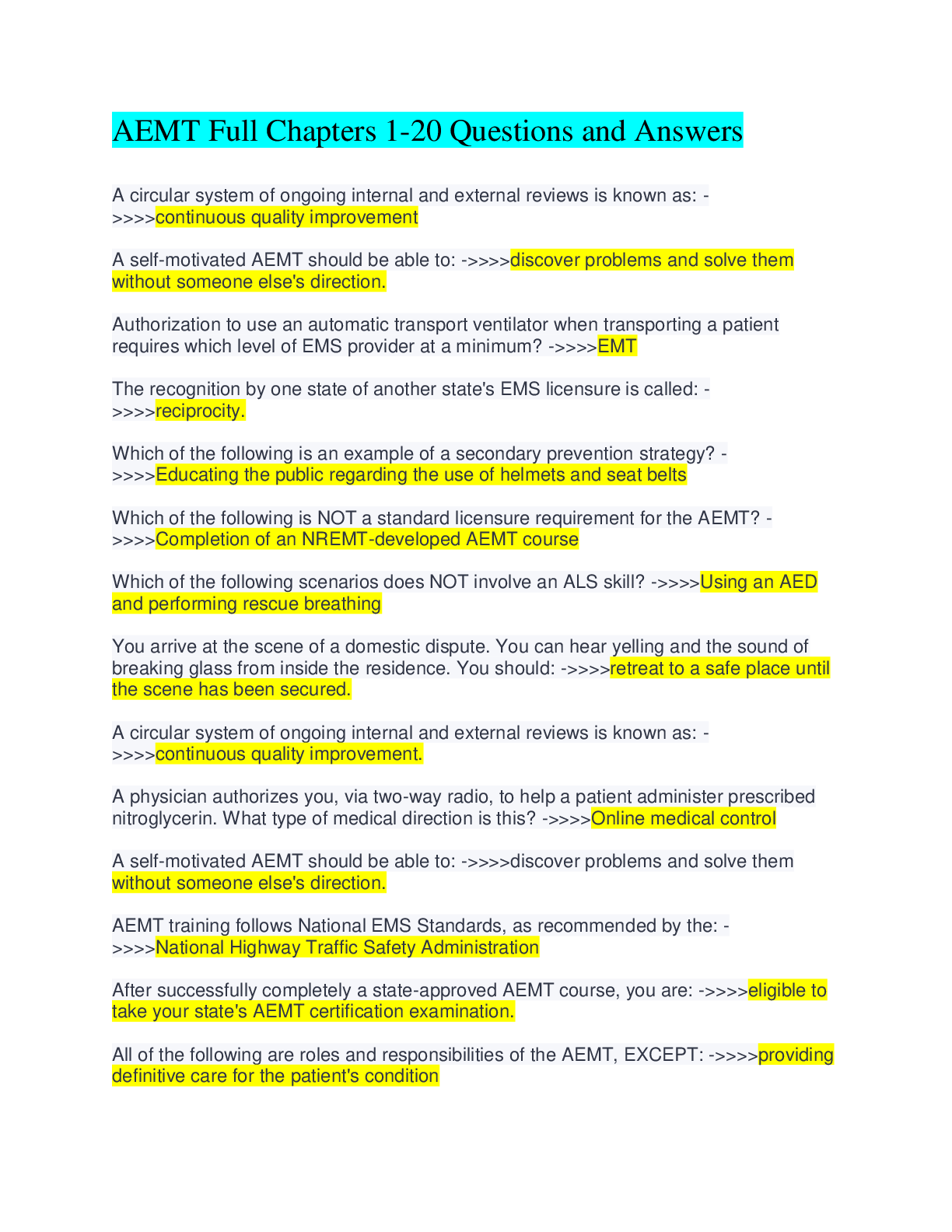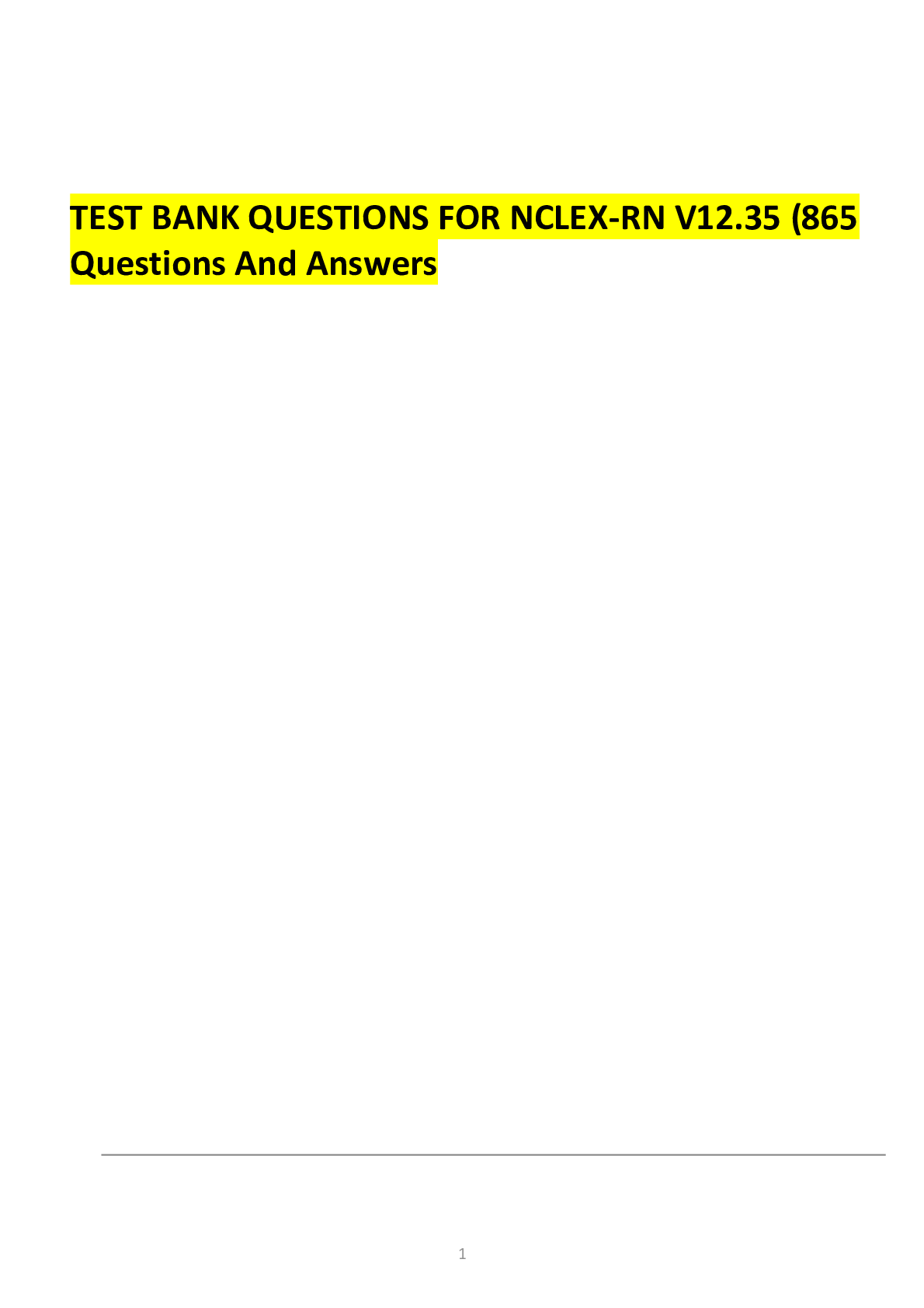*NURSING > TEST BANK > Test Bank for Roachs Introductory Clinical Pharmacology, 11th Edition,All Chapters, questions and co (All)
Test Bank for Roachs Introductory Clinical Pharmacology, 11th Edition,All Chapters, questions and correct answers with Rationales.
Document Content and Description Below
Test Bank for Roachs Introductory Clinical Pharmacology, 11th Edition,All Chapters, questions and correct answers with Rationales. 1. A nursing instructor is preparing a teaching plan for a group of ... nursing students about pharmacology. When describing this topic, the instructor would focus the discussion on which of the following as an essential aspect? A) Drug name B) Drug class C) Drug action D) Drug source 2. A nursing student is preparing to administer a prescribed drug to a patient. The student reviews information about the drug and its actions. Which of the following would be the best choice for obtaining this information? Select all that apply. A) Nursing instructor B) Nurse assigned to the patient C) Clinical drug reference D) Prescribing health care provider E) Clinical pharmacist 3. When describing the various types of medications to a group of nursing students, a nursing instructor would identify which of the following as a source for deriving medications? Select all that apply. A) Plants B) Synthetic sources C) Mold D) Minerals E) Animals 4. Which of the following names may be assigned to a drug during the process of development? Select all that apply. A) Chemical name B) Official name C) Pharmacologic name D) Trade name E) Nonproprietary name 5. A drug may be classified by which of the following? Select all that apply. A) The chemical type of the drug's active ingredient B) The way the drug is used to treat a specific condition C) The generic name of the drug D) The trade name of the drug E) The nonproprietary name of the drug 6. A group of nursing students are reviewing information about the process of drug development in the United States. The students demonstrate understanding of this process when they identify that which of the following categories are assigned by the Food and Drug Administration to newly approved drugs? Select all that apply. A) Metabolite B) Noncontrolled substance C) Prescription D) Nonprescription E) Controlled substance 7. Which of the following would be most important for the nurse to do to ensure the safe use of prescription drugs in the institutional setting? Select all that apply. A) Administering drugs B) Monitoring clients for drug effects C) Prescribing drugs D) Evaluating clients for toxic effects E) Educating clients/caregivers about drugs 8. The nurse is helping a client review a prescription from the health care provider. When examining the prescription, which of the following would the nurse expect to find documented? Select all that apply. A) Name of the drug B) Dosage of the drug C) Route of drug administration D) Times of drug administration E) Licensed prescriber's signature 9. After teaching a group of nursing students about nonprescription drugs, the nursing instructor determines that the teaching was successful when the students identify which of the following? Select all that apply. A) They require a licensed health care provider's signature. B) They are referred to as over-the-counter drugs. C) They can be taken without risk to the client. D) They have certain labeling requirements. E) They should be taken only as directed on the label. 10. A nursing student is reviewing information about the Controlled Substances Act of 1970. The student would expect to find which of the following as being regulated for drugs classified as controlled substances? Select all that apply. A) Manufacturing B) Elimination C) Distribution D) Formulation E) Dispensing 11. When reviewing information about the Orphan Drug Program, which of the following would the nurse expect to find? Select all that apply. A) The program encourages the development and marketing of products to treat rare diseases. B) The program grants provisional approval with a written commitment from the drug company to formally demonstrate client benefits. C) The program provides for incentives, such as research grants, protocol assistance, and special tax credits, to develop products to treat rare diseases. D) The program grants 7 years of exclusive marketing rights to the manufacturer if approved. E) The program accelerates approval of drugs based on preliminary evidence before formal demonstration of client benefits. 12. After teaching a group of nursing students about pharmacokinetics, the instructor determines that the teaching was successful when the students identify which of the following as a phase? Select all that apply. A) Absorption B) Distribution C) Administration D) Metabolism E) Excretion 13. A nurse is preparing a teaching plan for a client who is prescribed an oral medication. As part of the plan, the nurse expects to describe the importance of absorption. The nurse would integrate knowledge of which of the following as a mechanism for absorption in the gastrointestinal tract? Select all that apply. A) Active transport B) Transposition C) Passive transport D) Endocytosis E) Pinocytosis 14. After teaching a group of nursing students about the half-life of a drug, the instructor determines the need for additional teaching when the students identify which of the following as true? Select all that apply: A) Half-life can be decreased in clients with renal disease. B) Half-life can help determine dosing frequency. C) Half-life does not change throughout a client's life. D) Liver disease can increase half-life. E) Half-life is the measure of the rate at which drugs are removed from the body. 15. A nurse is assessing a client after administering a prescribed medication. Which of the following would alert the nurse to suspect that the client is developing anaphylactic shock? Select all that apply. A) Bradycardia B) Hypertension C) Dyspnea D) Urticaria E) Angioedema 16. Which of the following would the nurse identify as a factor that alters drug response in children and infants? Select all that apply. A) Slower gastric emptying B) Greater surface area C) Less protein binding D) Decreased body water content E) Less cutaneous fat 17. The FDA established a safety information and adverse events reporting program called MedWatch. Which individuals can access the MedWatch website to obtain safety alerts on drugs, devices, or dietary supplements? Select all that apply. A) Physicians B) Nurses C) Patients D) Pharmacists E) Caregivers 18. A nurse is preparing to administer a prescribed medication to a client. The nurse integrates knowledge of which of the following as a possible factor that could influence the drug response? Select all that apply. A) Age B) Polypharmacy C) Weight D) Sex E) Disease 19. A nurse is assessing a client and notes that the client has developed swelling of the eyelids and lips after administration of a prescribed medication. The nurse interprets this finding as specifically indicating which of the following? A) Mild allergic reaction B) Anaphylactic shock C) Angioedema D) Drug idiosyncrasy 20. Which of the following is true regarding the Dietary Supplement Health and Education Act (DSHEA)? Select all that apply. A) The act allows for DEA enforcement of the act. B) The act gives the FDA power to enforce the laws governed by the act. C) The act permits general health claims. D) The act permits curative health claims. E) The act defines specific substances as “dietary supplements.” 21. When reviewing the phases of drug development, the nurse finds a discussion about the postmarketing surveillance phase. Which one of the following activities would the nurse expect to find as being carried out during this phase? A) Health care providers report adverse effects to FDA. B) Healthy volunteers are involved in the test. C) In vitro tests are performed using human cells. D) The drug is given to patients with the disease. 22. A nurse is assessing a pregnant client and learns that the client is addicted to cocaine. The nurse informs the client about the risks of cocaine addiction for her fetus. Which of the following would the nurse include? A) The child may be born with diabetes. B) The child may be born with hypertension. C) The child may be born with an addiction to drugs. D) The child may be born with CNS defects. 23. A patient arrives at the health care clinic and informs the nurse that he has consumed several aspirin tablets for a severe headache over the past 24 hours. The nurse would be alert for which of the following as a harmful effect? A) Gastrointestinal bleeding B) Breathing difficulties C) Visual disturbances D) Loss of balance 24. The nurse observes that after administration of a drug the patient has developed itching and a skin rash. The nurse interprets these findings as which of the following? A) Toxicity B) Allergic reaction C) Angioedema D) Crystalluria 25. A patient is receiving digoxin as treatment for heart failure. Which of the following would be most important for the nurse to monitor to reduce the risk for toxicity? A) Seizure activity B) Drug blood level C) Urinary output D) Blood pressure 26. A patient has been using sleeping pills every night for the past several months. Now admitted to the hospital, he is prescribed his usual dose of sleeping pill. After administration, the patient continues to be restless and is wide awake. The nurse notifies the health care provider, who prescribes an increased dose. After receiving the new dose, the patient falls asleep. The nurse interprets this as which of the following? A) Drug idiosyncrasy B) Cumulative drug effect C) Drug tolerance D) Toxic reactions 27. A patient wants to know about the possible interactions of the various drugs that he has been prescribed for an illness. The nurse explains that the drugs interact with each other and produce an effect that is greater than the sum of their separate actions. Which of the following reactions is the nurse informing about? A) Additive drug reaction B) Synergistic drug reaction C) Antagonistic drug reaction D) Toxic drug reaction 28. A nurse has administered drugs to a patient as per the physician's orders. Which of the following activities should the nurse perform after administering the prescribed drugs to the patient? A) Record symptoms of the condition. B) Perform a culture and sensitivity test. C) Obtain history of drug allergy. D) Check for adverse drug reactions. 29. The nurse administers a prescribed medication that is supplied as an enteric-coated tablet. The patient asks the nurse about this form of tablet. When describing how this tablet is absorbed, which response by the nurse would be most accurate? A) “The medication dissolves directly from the stomach into the body.” B) “The drug breaks up into pieces as it moves through the stomach.” C) “The medication bypasses the GI tract and goes quickly into the bloodstream.” D) “The drug dissolves into fragments after it reaches your small intestine.” 30. After teaching a group of nursing students about pharmacokinetics, the instructor determines that the teaching was successful when the students identify which of the following as the first phase? A) Metabolism B) Absorption C) Distribution D) Excretion 31. A patient is considering using herbal supplements and asks the nurse about them. Which response by the nurse would be most appropriate? A) “Herbal supplements are safe to use because they are regulated closely.” B) “Herbal supplements can affect the way other medications will act.” C) “Taking more than the recommended amount usually is not harmful because they are natural.” D) “The risk of the supplement interacting with any prescription medications is extremely low.” 32. A nurse is reading a journal article about seasonal allergies and comes across the name of the drug loratadine. The nurse identifies this drug name as which of the following? A) Chemical B) Generic C) Trade D) Brand 33. A group of nursing students are reviewing information about drug development in the United States in preparation for an exam. The students demonstrate understanding of this material when they identify testing of which of the following as one of the first steps? A) Small group of healthy volunteers B) People who have the disease C) Live animals D) Large numbers of patients 34. After teaching a group of nursing students about pharmacokinetics, the instructor determines that the teaching was successful when the students identify which of the following as the site for the metabolism of most drugs? A) Liver B) Lungs C) Kidneys D) Intestinal mucosa [Show More]
Last updated: 1 year ago
Preview 1 out of 607 pages
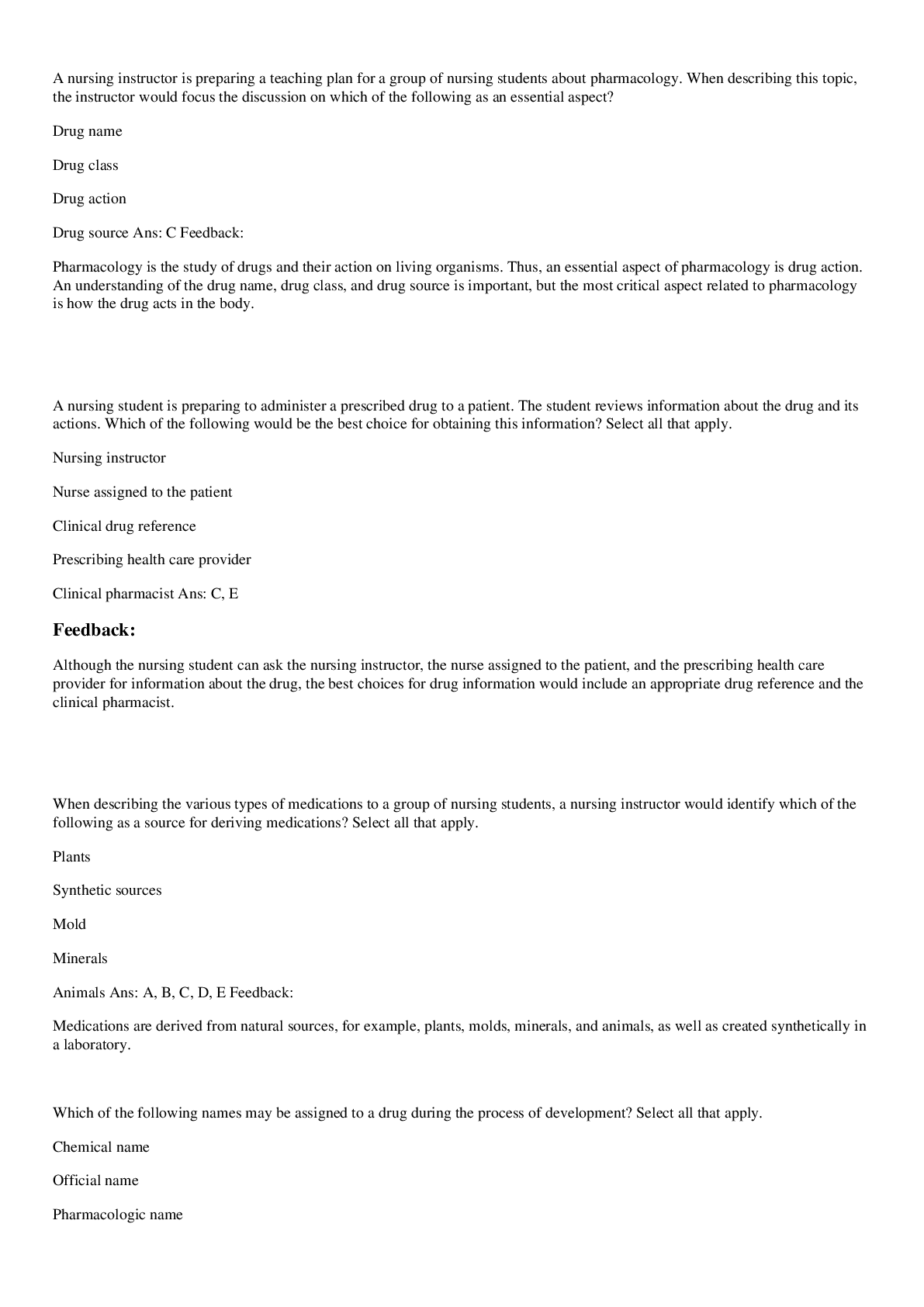
Reviews( 0 )
Document information
Connected school, study & course
About the document
Uploaded On
Aug 10, 2021
Number of pages
607
Written in
Additional information
This document has been written for:
Uploaded
Aug 10, 2021
Downloads
0
Views
29

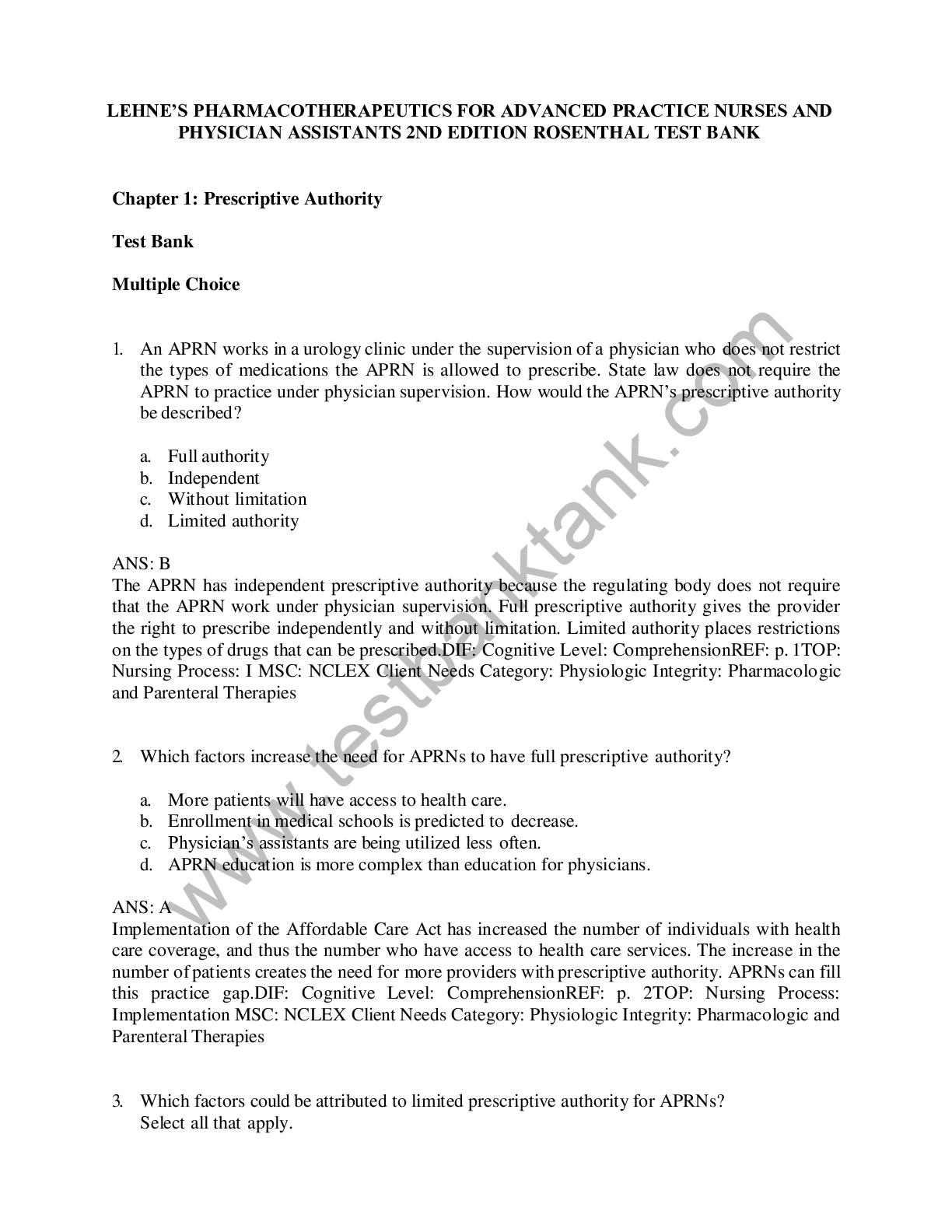
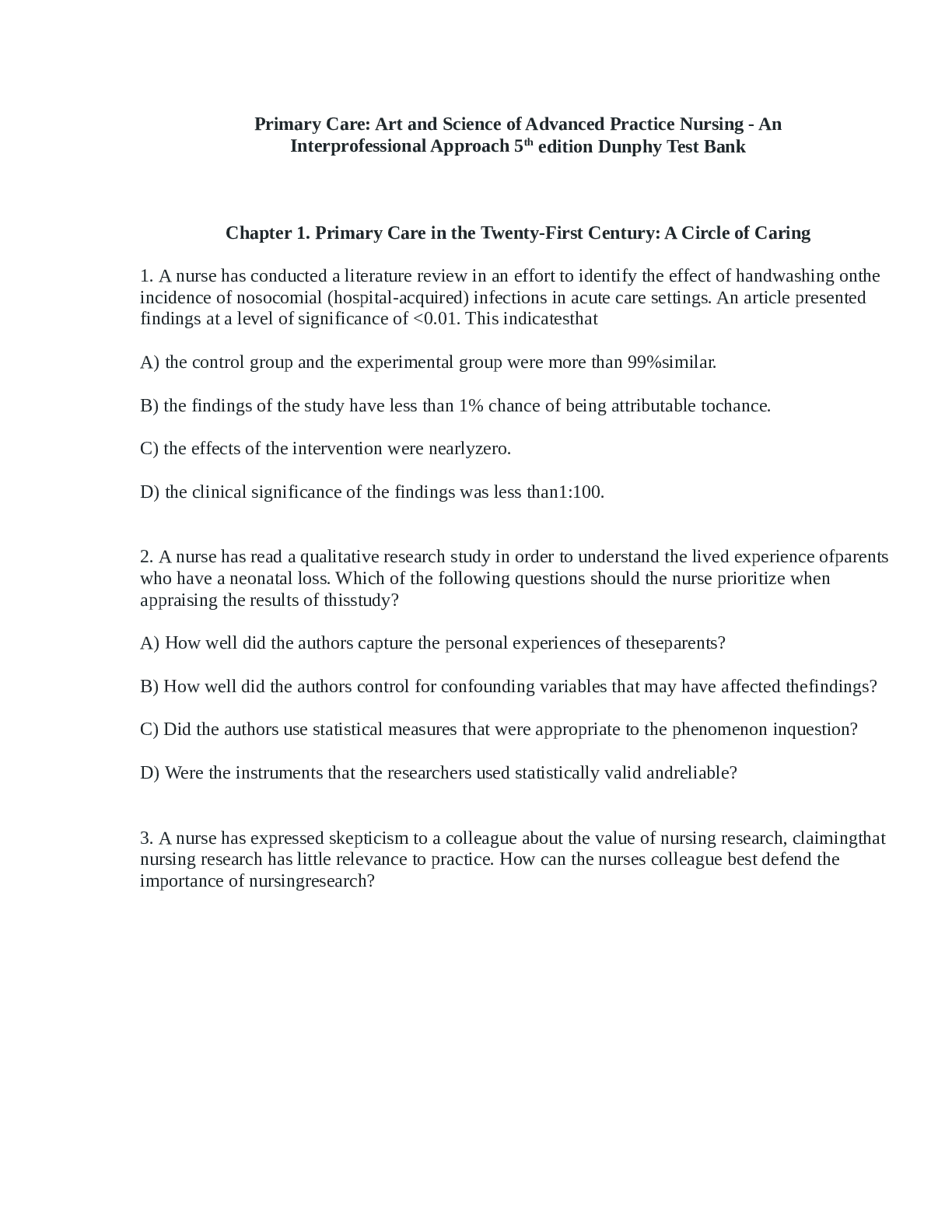
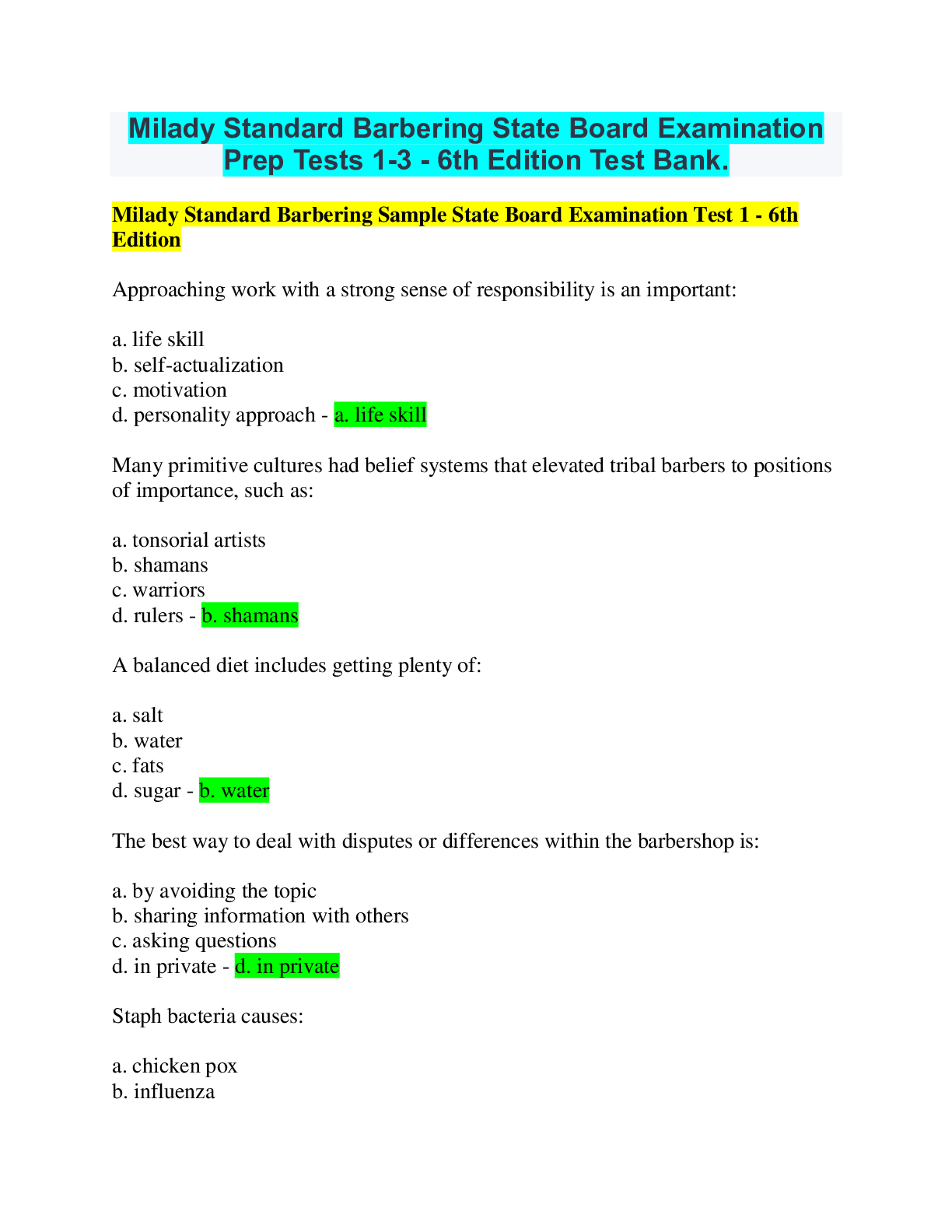
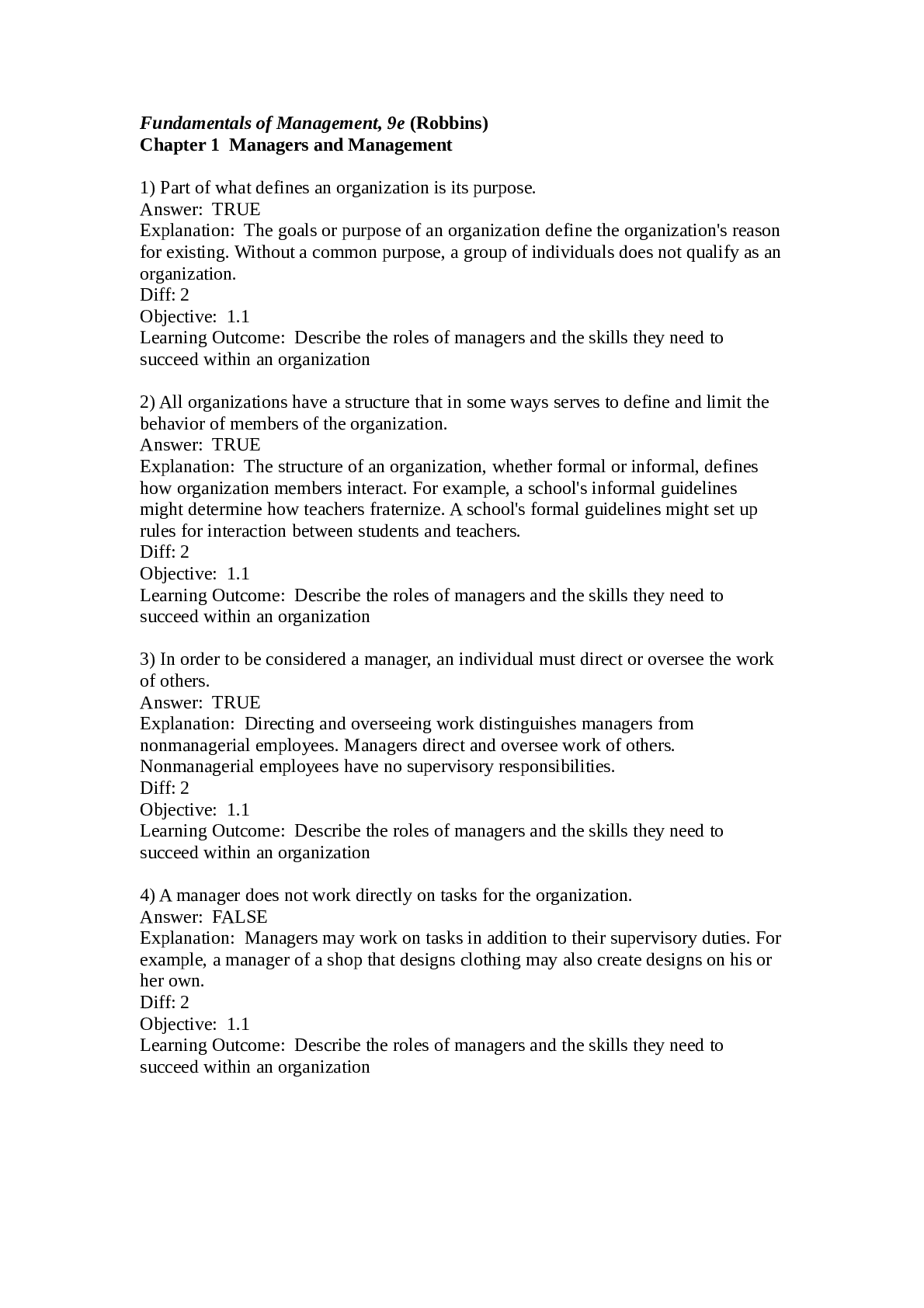
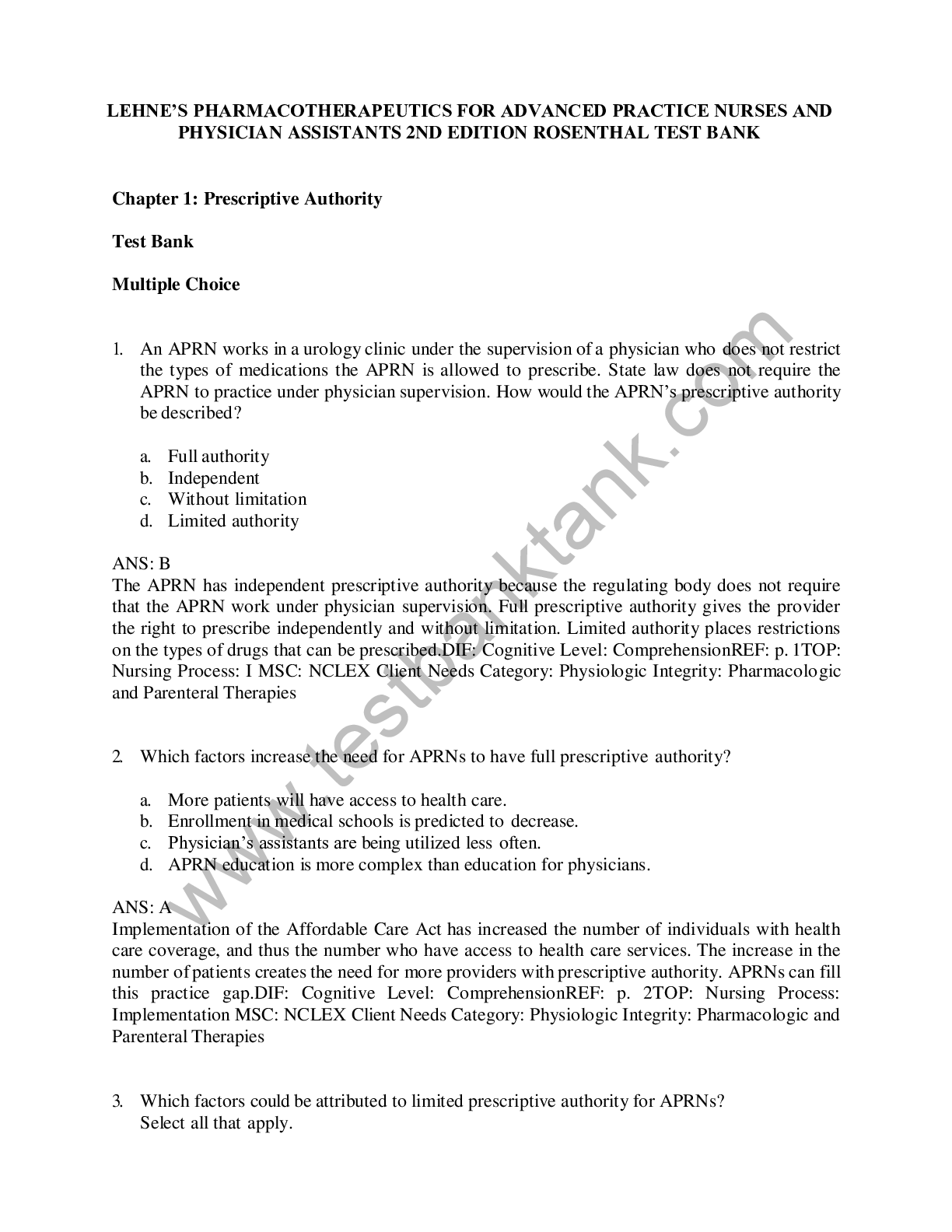
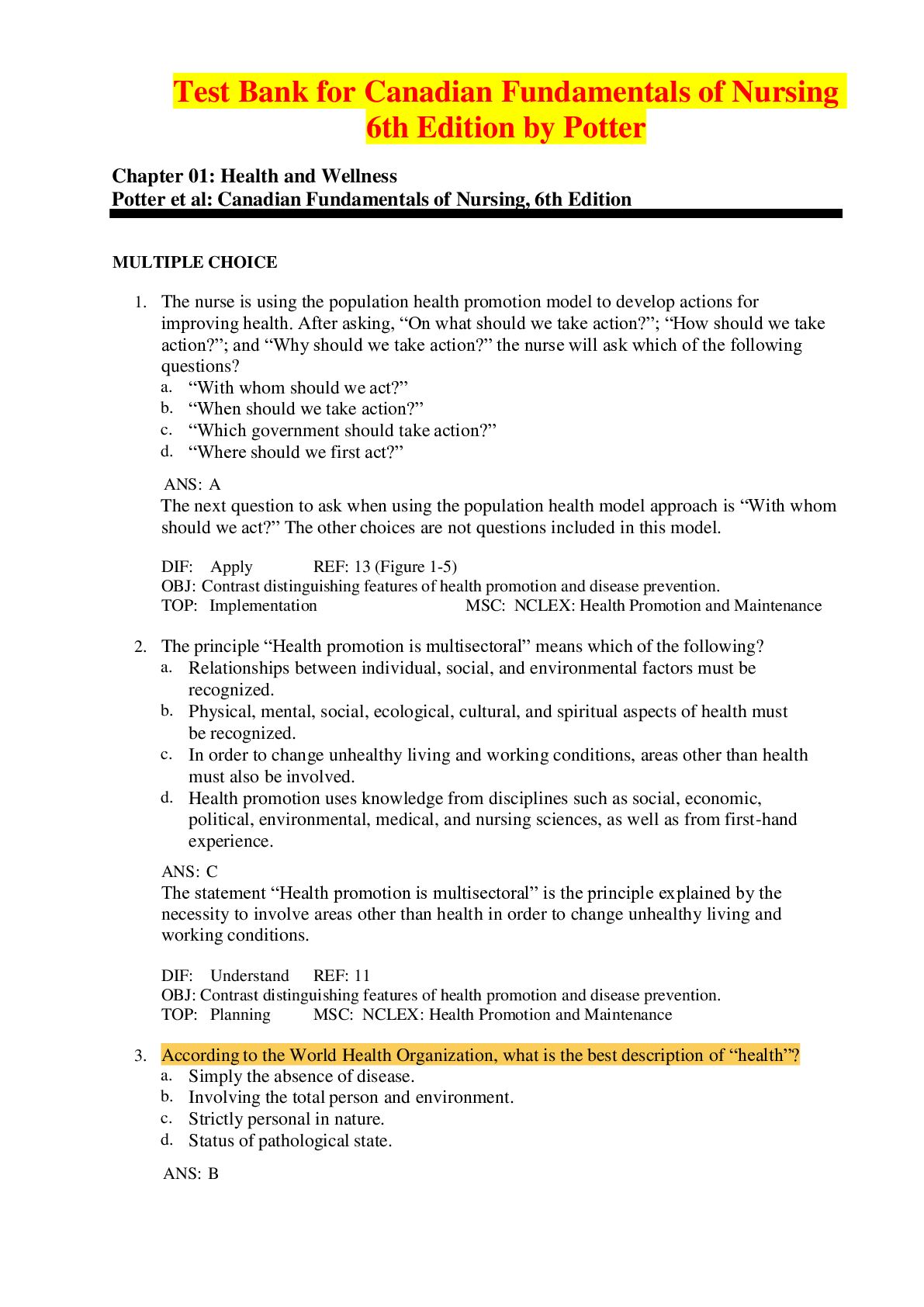
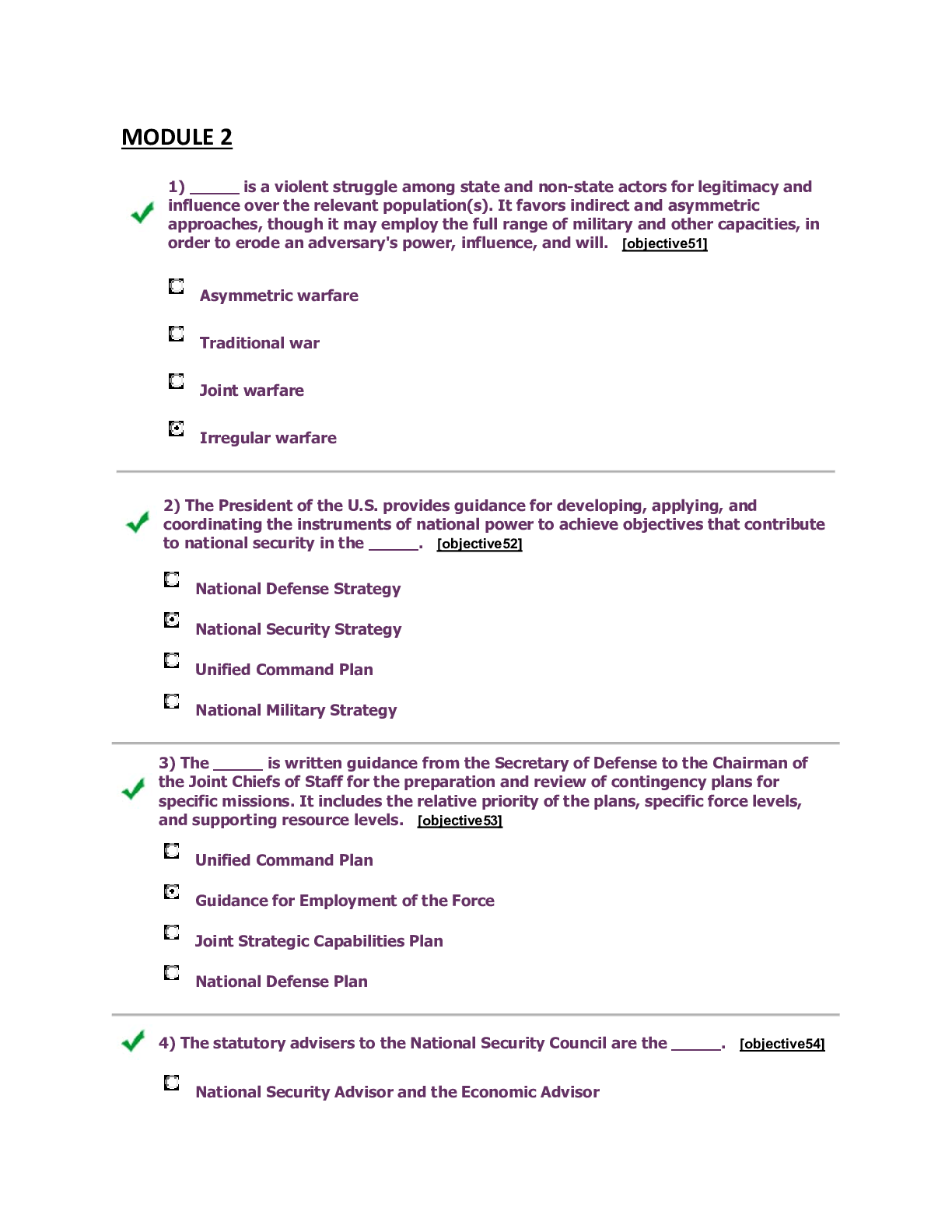
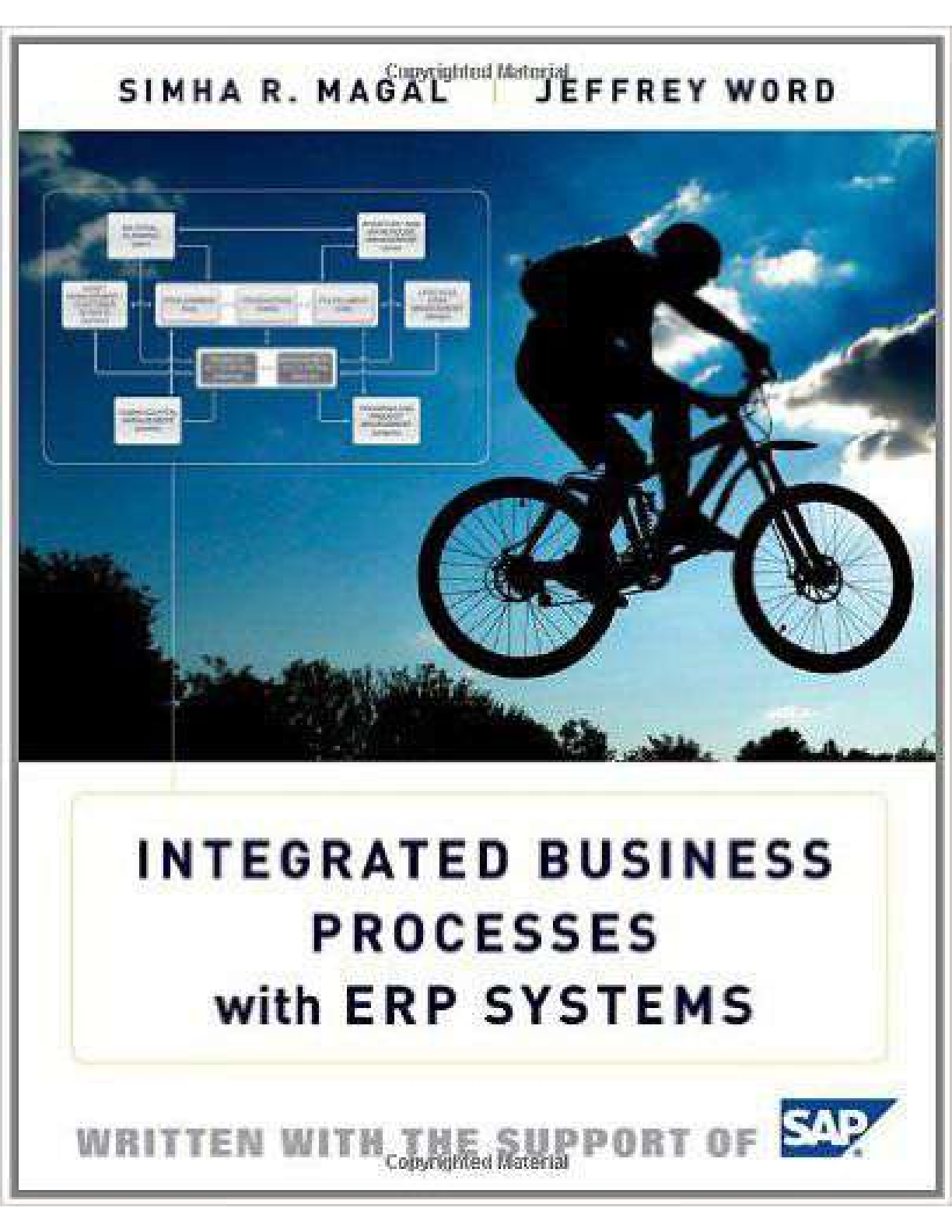
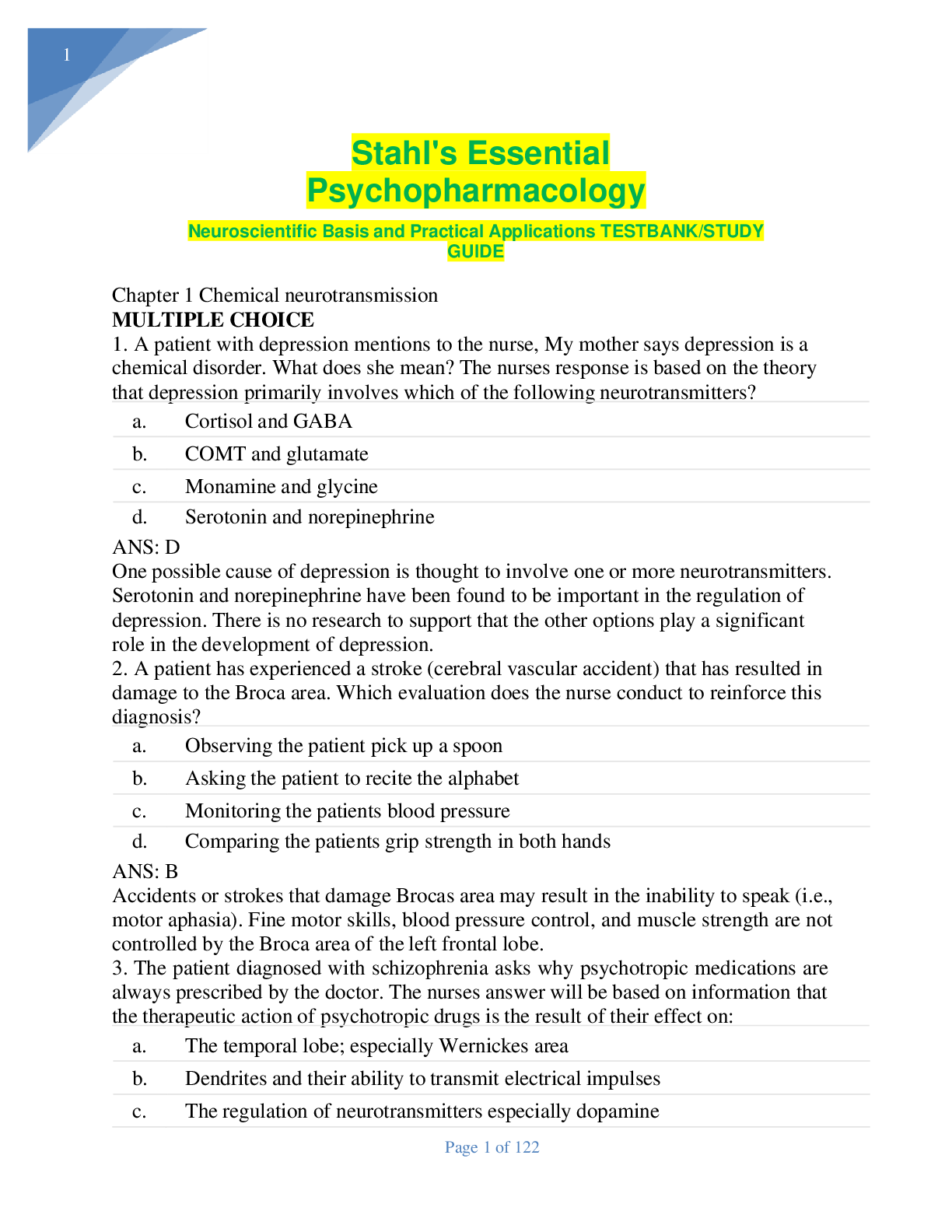
.png)
_compressed.png)
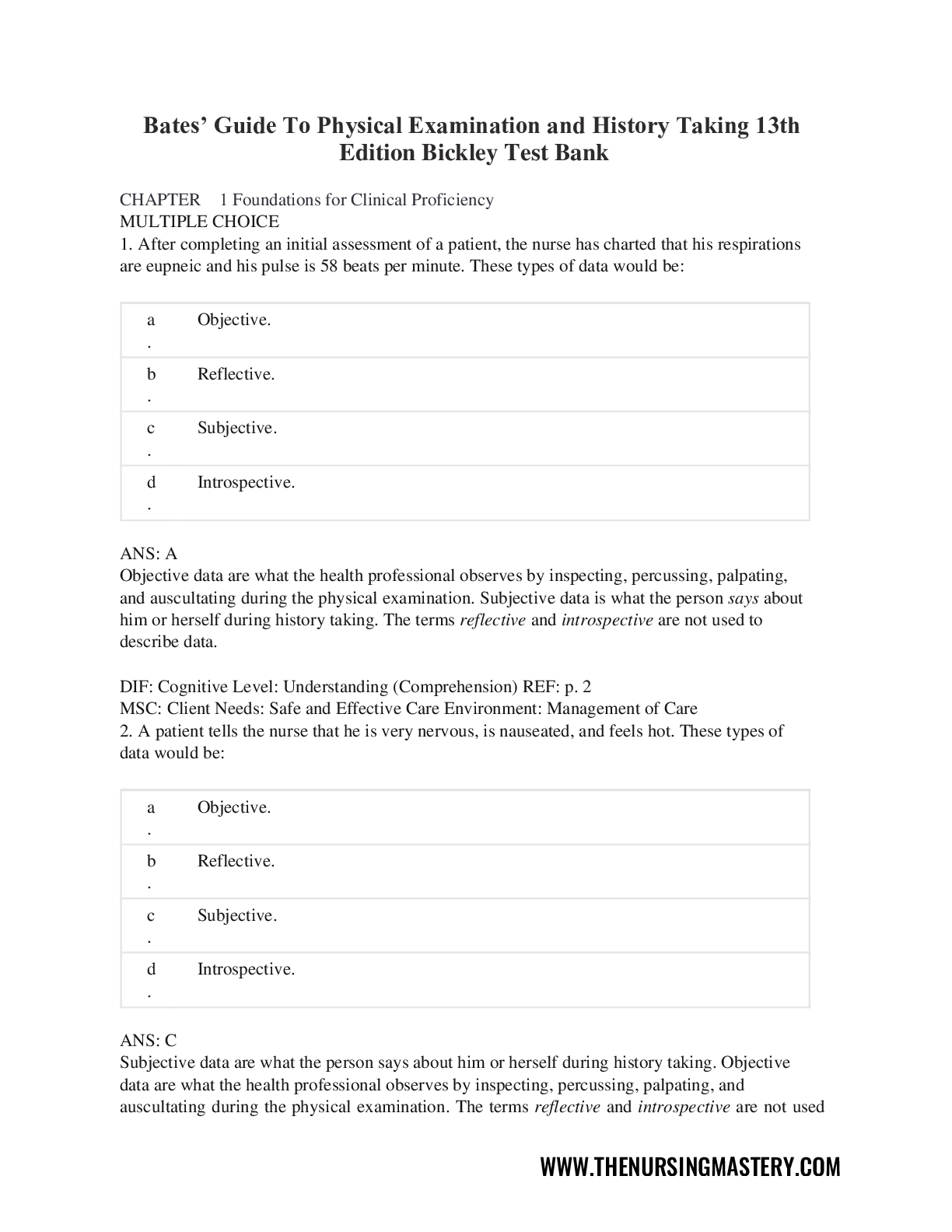
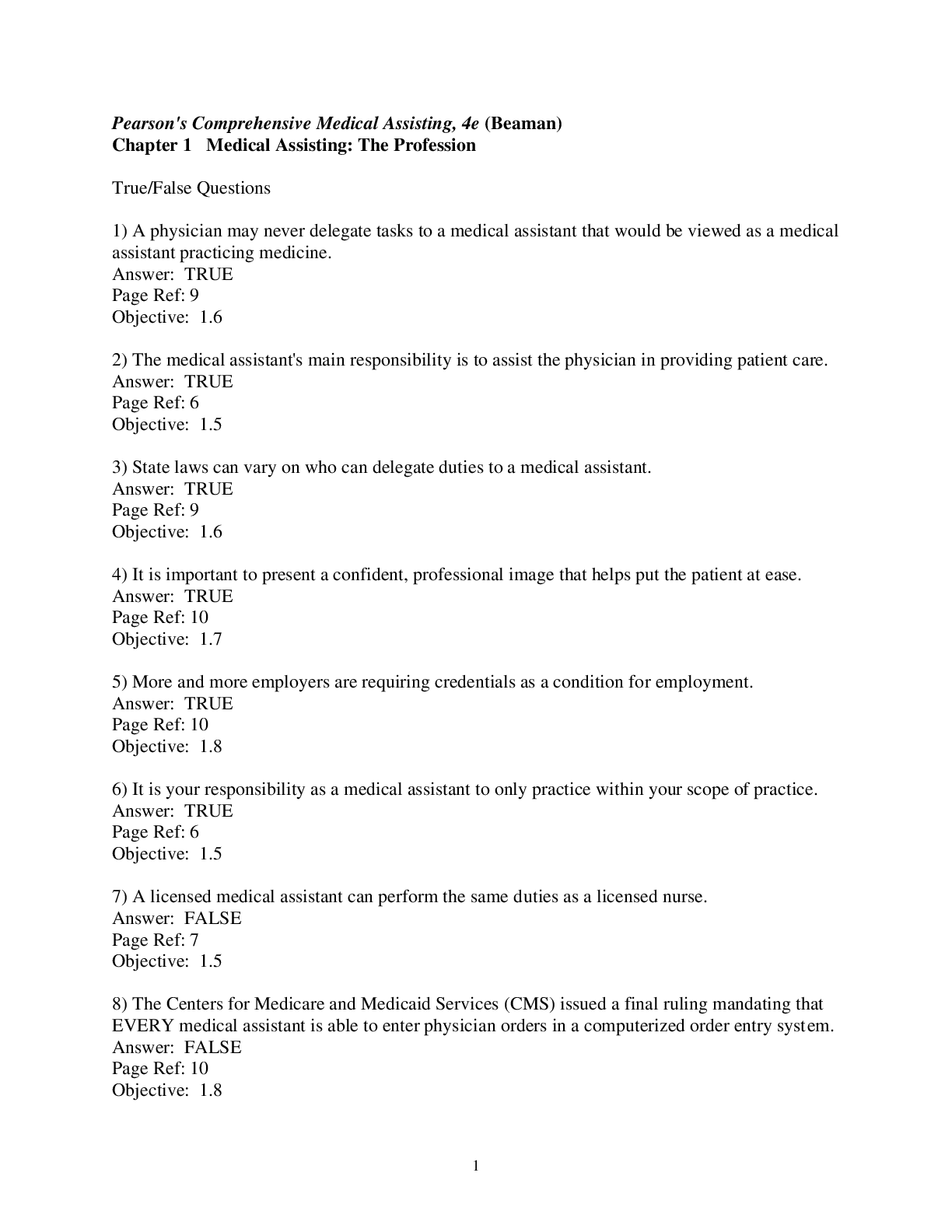
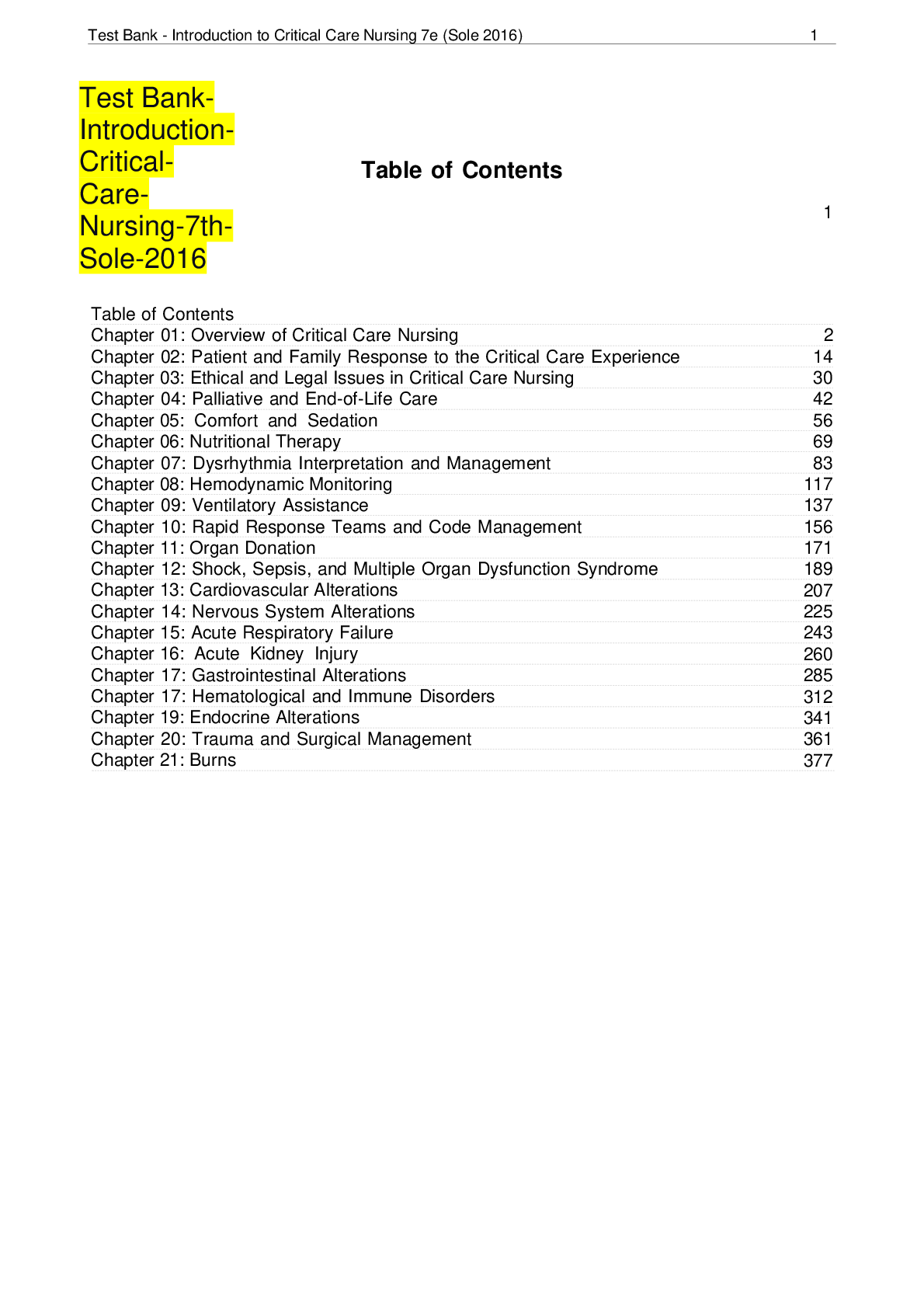
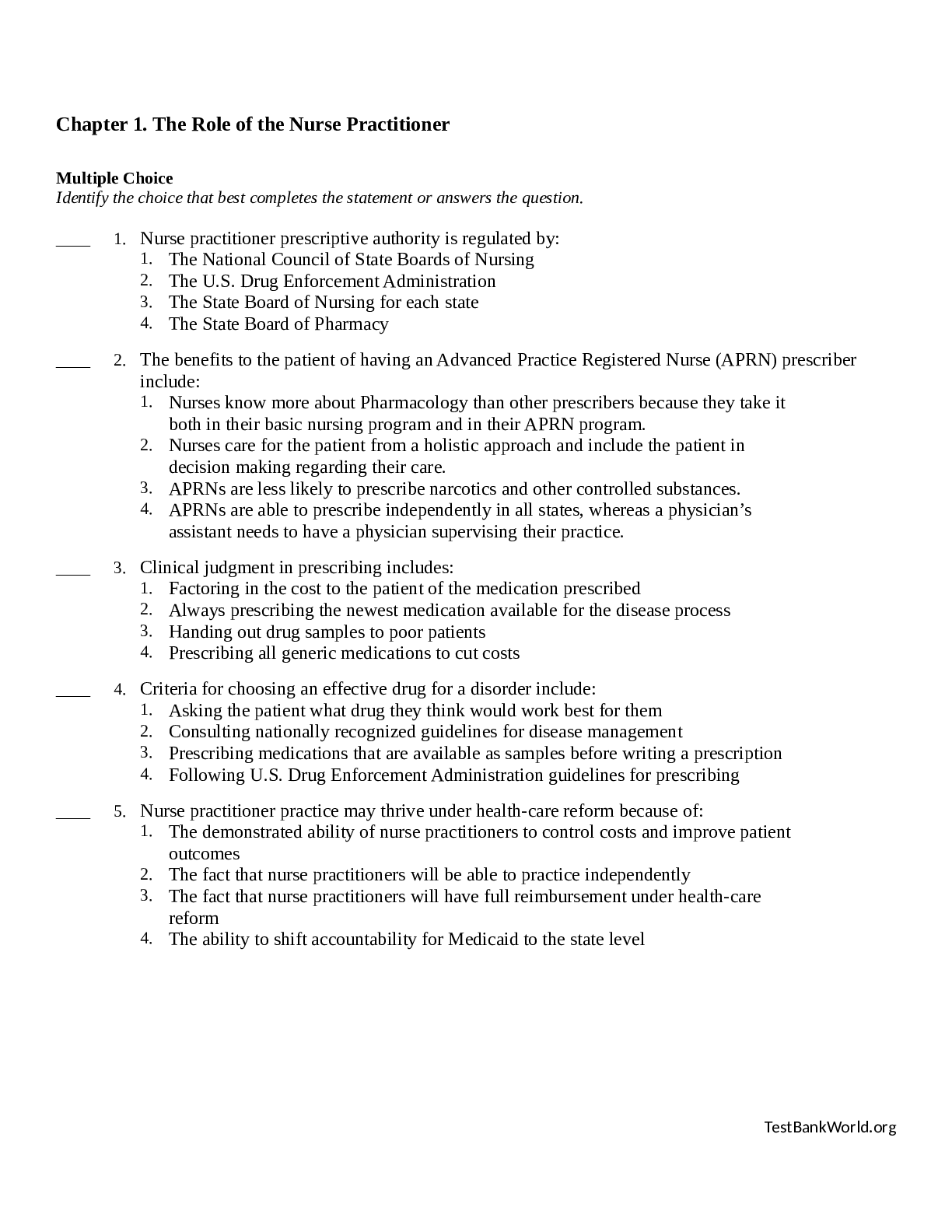
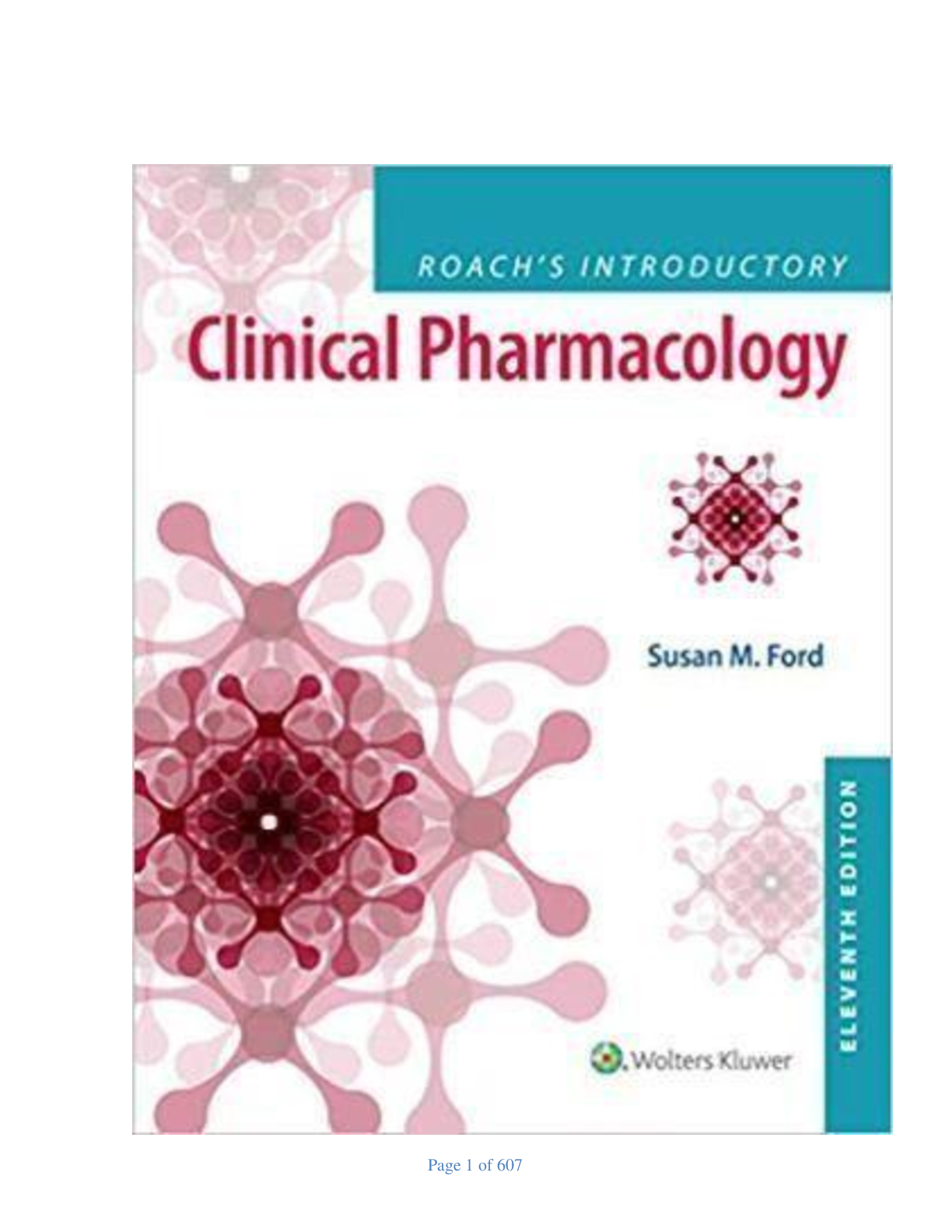


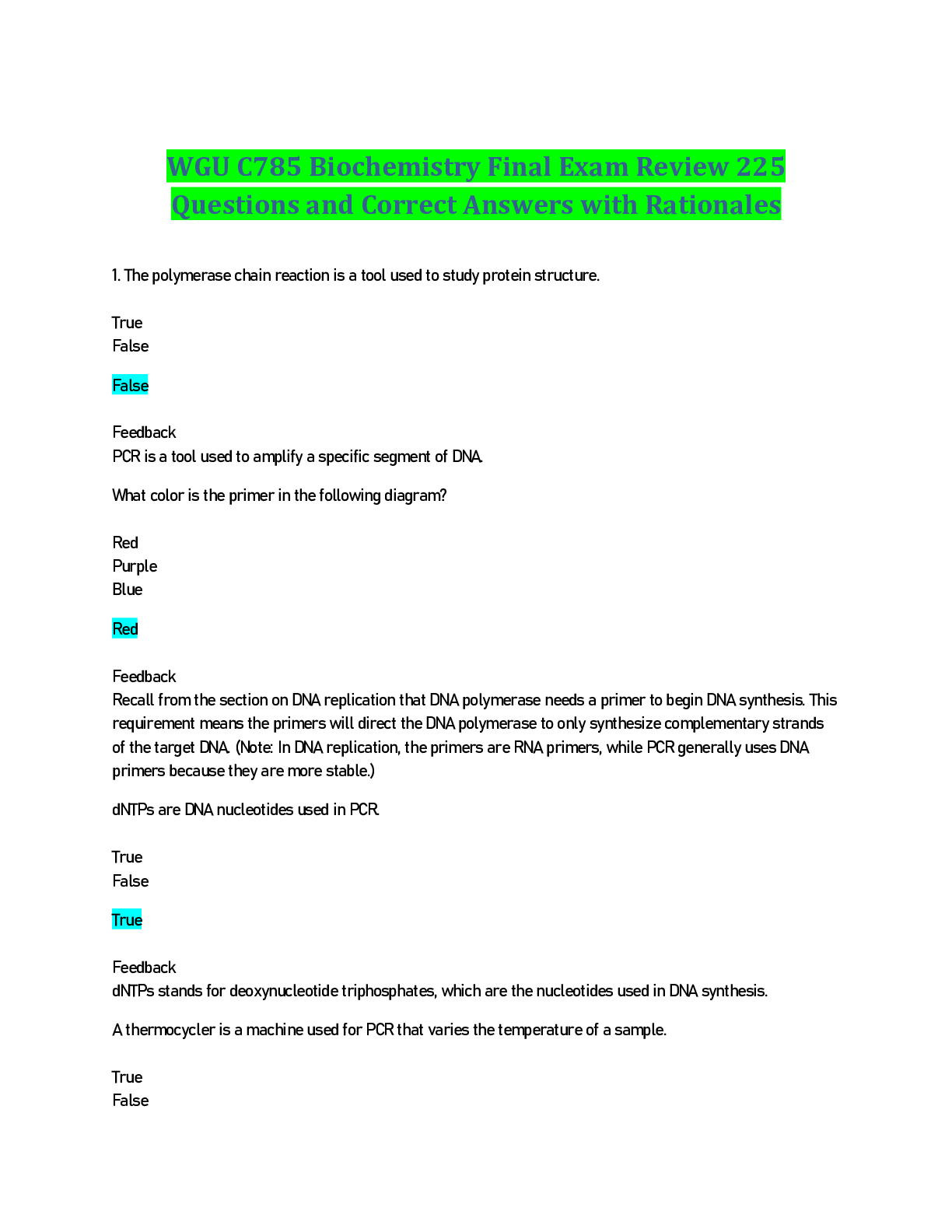


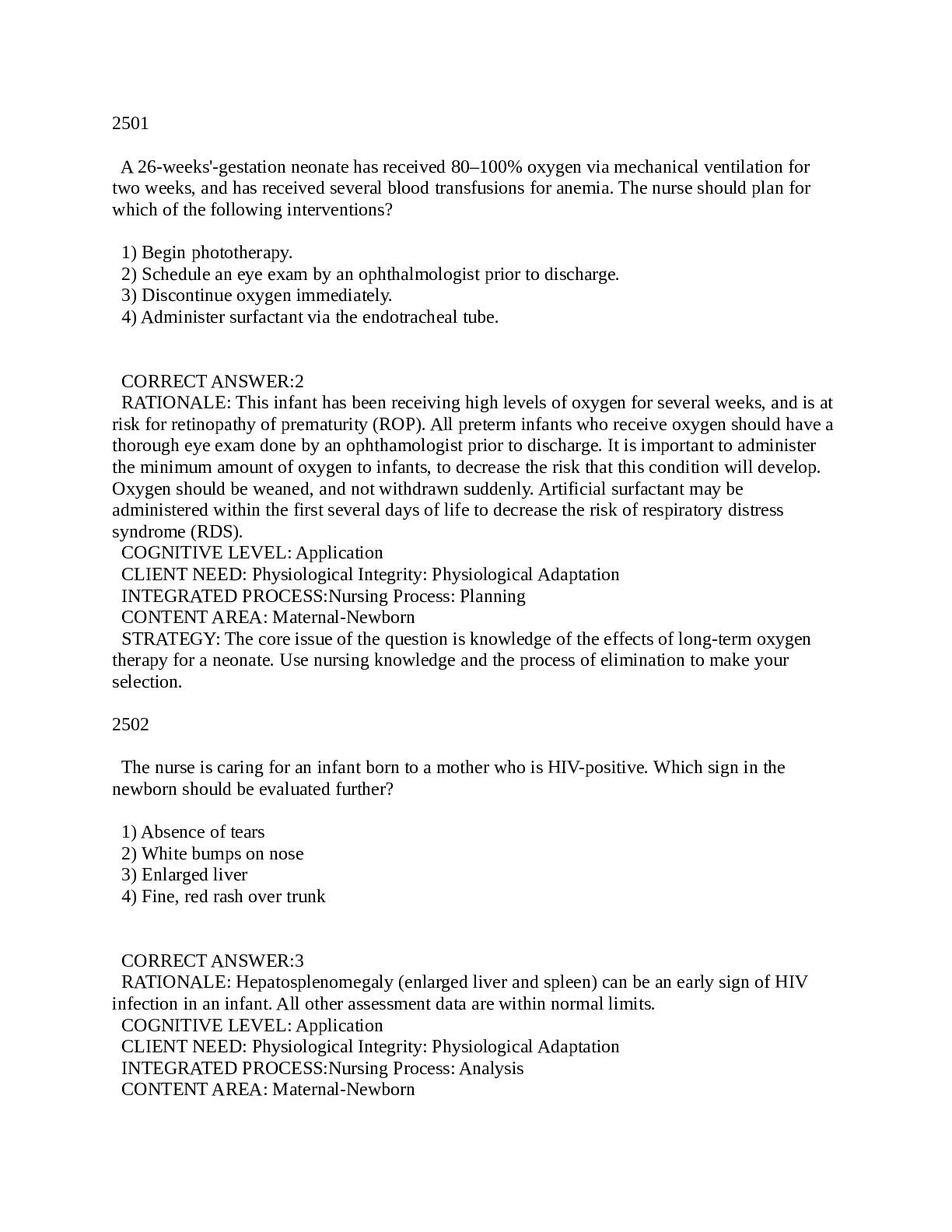
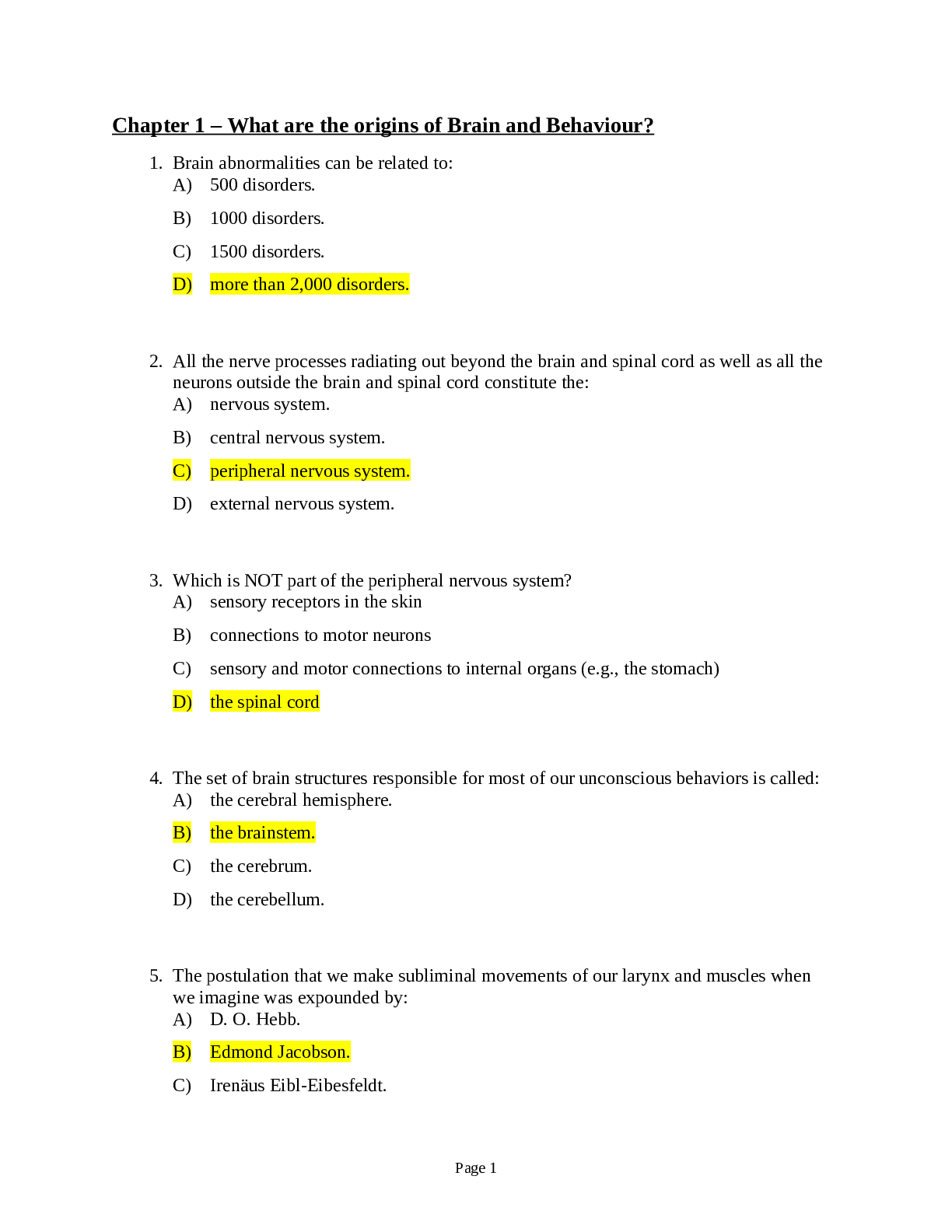

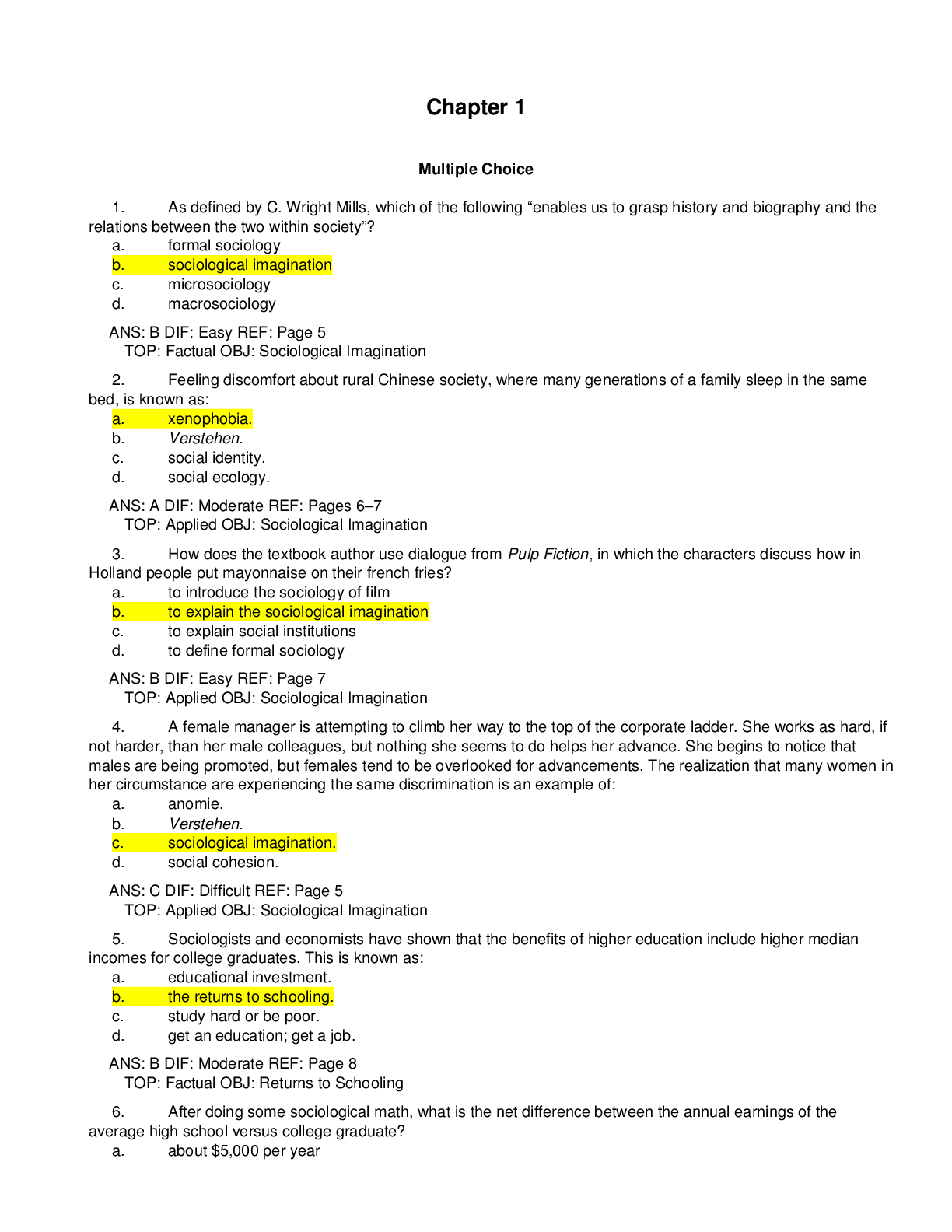
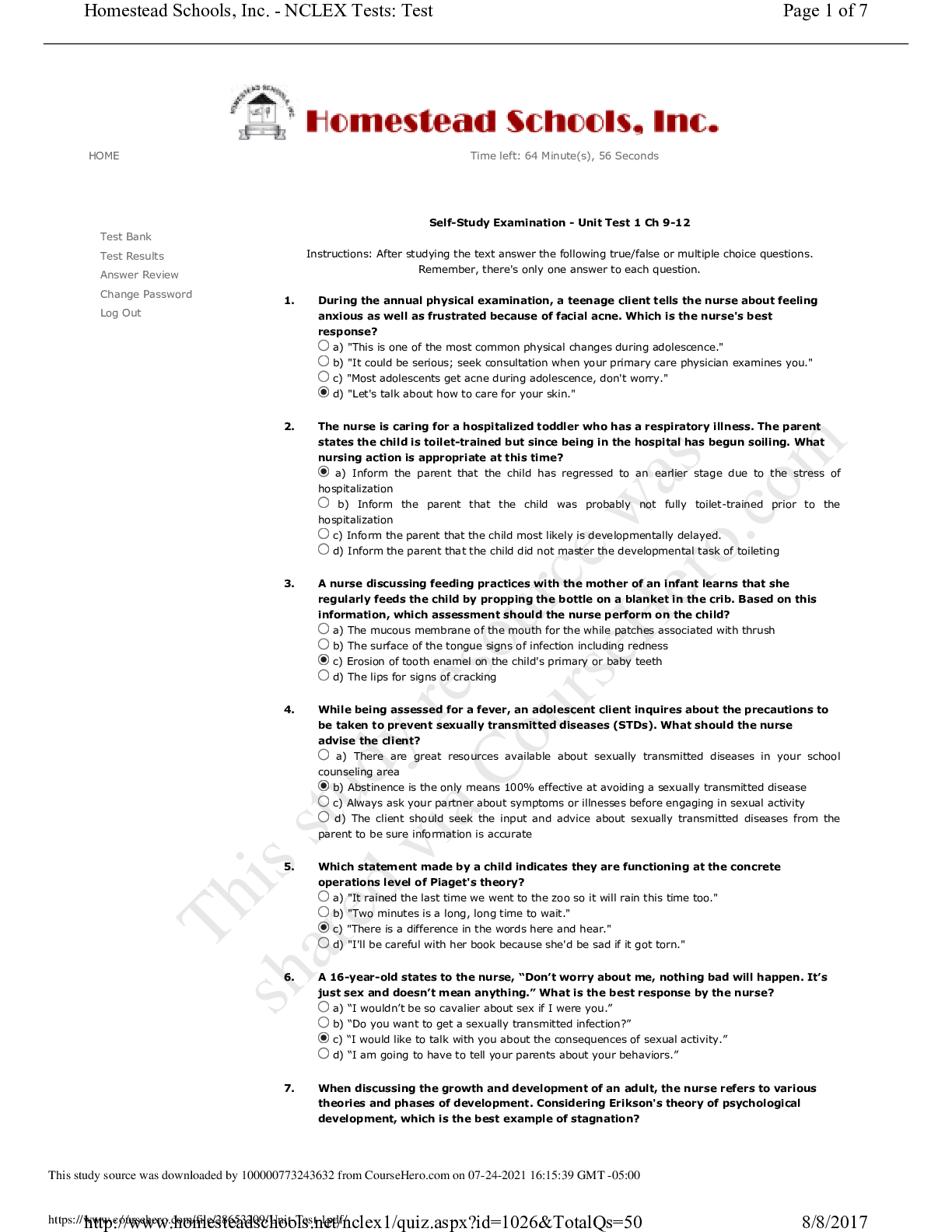

.png)
